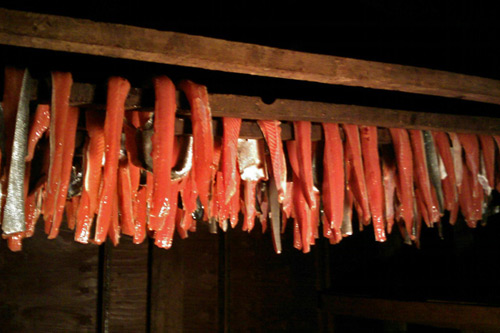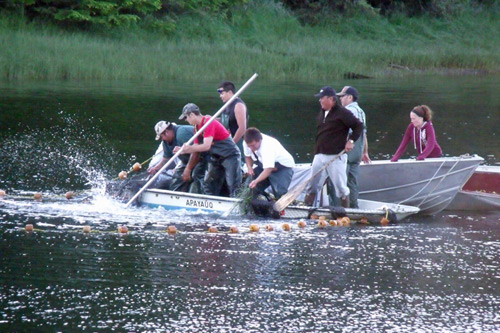On a September morning, a coastal lagoon in Alaska glistens like smooth glass. The Tlingit village on the shore is still quiet. But a delectable aroma in the air reveals something at work: salmon were hung in the smokehouse with care. Alder smoke now wafts across the lagoon, down the lanes of the village and past a curtain of lush rainforest.
People in the village of Klawock, pop. 813, live with salmon in spring, summer, fall and winter. Jon Rowan, whose ancestral roots in this place reach far back in time, says catching salmon – and sharing it with others – is at the center of everyday life.
“For generations, salmon have sustained our people,” he says. “Each year we catch and put up salmon for the coming winter. We take only the salmon we need for ourselves and for those who may not be able to harvest for themselves.”
Salmon is often served at the ceremonial potlatch, or koo.éex’, in Tlingit. Standing is measured not in what someone possesses, but in what is shared with others. “The wealth,” Rowan says, “gets spread around a lot.”
Now in the depths of winter, larders in many Alaska homes are stocked with salmon put up in glass jars. At Rowan’s home, there’s a great variety: smoked, pickled, hash, salted, half-smoked, kippered. He’s an artisan.
When Rowan was younger, he fished with his older cousins and his clan leader, who taught him the intricacies of working the net, tending the smokehouse and caring for the tools of the subsistence fishing tradition. He also taught him something more: Always share the catch.
“I keep my freezer full,” he says. “If somebody in the village needs something, I’ve got extra.”
Fish Are Returning
Rowan, a carver, lives on Prince of Wales Island, at the southern tip of the Alaska panhandle. Most of the island’s 2,577 square miles fall within the Tongass National Forest, a place of rainforest and salmon streams. Totem poles – like those Rowan carves – stand tall in its Native villages.
The Nature Conservancy helped to fix a problem with a fish passage here in 2011. A highway built in 1964 blocked a natural tidal channel, and for nearly 50 years no fish passed through here. Today the natural fish passage is rebuilt. Tides are again carrying fish through this channel.
Rowan isn’t old enough to remember the way it was, but the history is well known. While assisting on archeological digs, Rowan has helped uncover ancestral fish weirs traditionally used for catching fish along the old channel.
Last summer, in the restored channel, Rowan watched the miracle of the salmon life cycle pass before his very eyes –– practically from his doorstep. And all of a sudden, kids with fishing rods catch salmon here.
Teaching to Give
The Tongass is home to all five species of North America’s Pacific salmon, but local Native tradition considers the sockeye salmon a favorite.
“It always has been, as far back as I can remember, and listening to my father talk, the sockeye has always been prized for its richness,” Rowan says. “It’s like the prime rib, you know?”
As he himself was taught, he now teaches his young nephews the lessons that serve them far beyond the confines of a fishing skiff, a household, or even a village.
“We’re teaching them the same values we learned when we first started out,” he says. “They learn their responsibilities not only to their immediate family but to the rest of their community. You help everybody.”
[First image: Strips of wild sockeye salmon hang in a traditional smokehouse in the Tlingit village of Klawock, Alaska. Image source: Eva Rowan. Second image: Jon Rowan leads young community members in subsistence salmon fishing. Image source: Amanda Armour]
The Nature Conservancy is the leading conservation organization working around the world to protect ecologically important lands and waters for nature and people.






